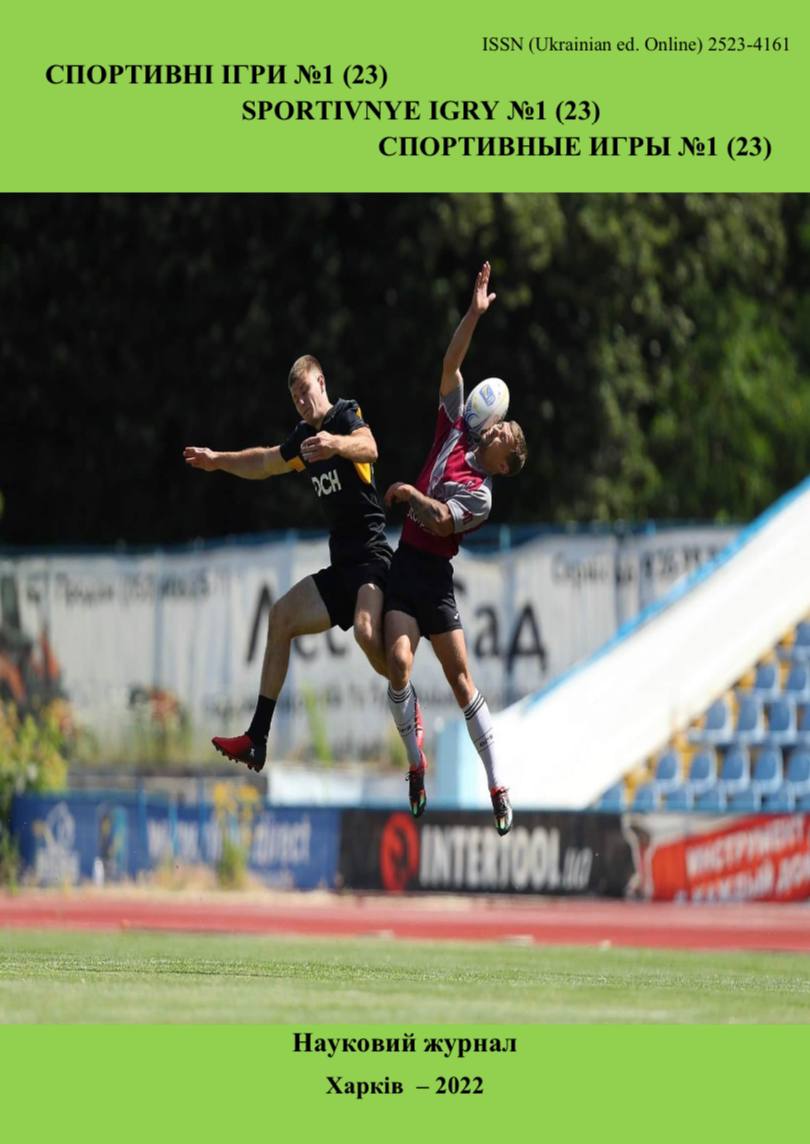Influence of means of playing ringo on the level of coordination abilities of sixth-graders
DOI:
https://doi.org/10.15391/si.2022-1.02Keywords:
ringo, coordination abilities, physical culture, sixth-gradersAbstract
Relevance of research. The game of ringo, on the one
hand, is the value of the ringo game as an accessible and interesting means of physical education
for students, and on the other - the need to test the effectiveness of sports on the level of
coordination skills of students. The purpose of the study is to determine the dynamics of indicators
of coordination abilities of sixth-graders in physical education lessons during the study of the ringo
game. Research participants. The study involved 55 students of 6th grade, the experimental group
consisted of 27 children (12 boys, 15 girls), and the control group consisted of 28 students (14 boys
and 14 girls). Research methods: theoretical analysis of scientific and methodological literature,
testing to assess the state of coordination skills (ability to maintain dynamic and static balance;
differentiation of spatial and temporal motion parameters; ability to respond), pedagogical
experiment, methods of mathematical statistics. Results of the research. Analysis of the results of
testing to determine the coordination abilities of students in the research groups showed that
children who studied according to the experimental method, using the means of playing the ringo,
had better results than peers with CG. Comparison of the test results showed that the students of the
experimental group showed a more pronounced increase in the level of coordination skills, and the
students of the CG such an increase in the indicators of coordination skills was not observed. In the
test "Walking on the bench" (ability to dynamic balance), the increase in the average result in the
EG at the end of the experiment was 4.5%; in the Romberg test (ability to static equilibrium) the
result increased by 36%; the increase in the test "Long jump from place to half of the effort" was
30%; in the test "Reaction-ball" - 10%; in the "Tapping test for hands and feet" - 24%. Obviously,
there is a pronounced tendency to increase the level of coordination capacity, in contrast to theresults of CG students. A comparison of the results of tests on the level of coordination skills at the
end of the formative experiment showed significant differences in the five tests conducted between
students of the control and experimental groups. And these differences are significant (P <0,05).
Conclusion. Analysis of the results of tests of coordination abilities of sixth-graders of research
classes showed that children who studied experimental technology were ahead of their peers with
CG in terms of tests on the ability to maintain dynamic balance, the ability to maintain static
balance; differentiation of spatial and temporal parameters of movement, as well as the ability to
respond. Therefore, it can be argued that the proposed technology of teaching the ringo is effective
not only in terms of students' mastery of the material from the ringo, but also helps to improve the
coordination skills of sixth-graders.
References
Бальсевич, В.К. (2000). Онтокинезиология человека. М. : Теория и практика физической культуры.
Виленский, М.Я. & Горшков, А.Г. (2020). Физическая культура : учебник. Москва : КНОРУС
Колумбет, О.М. (2014). Розвиток координаційних здібностей молоді : монографія. К. : Освіта України.
Круцевич, Т.Ю., Воробйов, М.І., & Безверхня, Г.В. (2011). Контроль у фізичному вихованні дітей, підлітків і молоді. К. : Олімп. л-ра.
Лаврін, Г.З., & Кучер, Т.В. (2009). Рінго – ефективний засіб фізичного виховання студентської молоді. Інноваційні підходи до фізичного виховання і спорту
студентської молоді. Тернопіль: ТНПУ ім. В. Гнатюка.
Лаврін, Г.З. & Середа, І.О. (2021). Вплив засобів гри в рінго на стан пізнавальних процесів шестикласників, Спортивні ігри, 2 (20), 23-33. doi: 10.15391/si.2021-2.02
Лаврін, Г.З., & Середа, І.О. (2019). Реалізація завдань професійно-прикладної фізичної підготовки студентів педагогічних вузів засобами гри в рінго, Спортивні ігри, 1(11), 16-23. doi.org/10.5281/zenodo.2543540
Лаврін, Г.З., & Середа, І.О. (2020). Результати опитування студентів, щодо ефективності застосування засобів гри рінго у процесі фізичного виховання, Спортивні ігри, 1(15), 25-33. doi: 10.15391/si.2020-1.03
Лях, В.И. (2000). Двигательные способности школьников: основы теории и методики развития. М: Терра Спорт.
Платонов, В.Н. & Булатова, М.М. (2004). Координация и методика ее совершенствования: Общая теория и ее практические приложения: учеб метод пособие. К.: Олимпийская литература.
Anioł-Strzyżewska, K. (2010). Ringo–jeszcze jedna pasja sportowo-organizacyjna prof. W. Starosty.[W:] Kariera naukowa czy pasja życia.
Lavrin, H., Sereda, I., Kucher, T., Grygus, I., Cieślicka, M., Napierała, M., Muszkieta, R. & Zukow, W. (2019). Efficiency Means the Game Ringo the Classroom Physical
Education. International Journal of Applied Exercise Physiology, 8, 3 (Sep. 2019), 8-15. doi: 10.26655/IJAEP.2019.9.2
Starosta, W., & Strzyżewski, W. (2010). Ringo – polska gra sportowa dla każdego. (Historia, technika, metodyka, taktyka, wyniki, przepisy). [Електронний ресурс]. Режим доступу: http://www.ringo.org.pl/index.php/o-ringo/ringo-polska-gra-sportowa
Starosta, W. (2006). Poziom koordynacji ruchowej i skoczności uprawiających ringo.[W:] Globalna i lokalna koordynacja ruchowa w wychowaniu fizycznym i sporcie (W.
Starosty). Międzynarodowe Stowarzyszenie Motoryki Sportowej, 19, 326-333.
Starosta W, & Wangryn M. Ringo – Polish Sports Game for Everybody. [Електронний ресурс]. Режим доступу: http://irf.ringo.org.pl/index.php/game-rules/ringo-polish-sports-game-foreverybody.
Starosta, W., & Wangryn, M. (2012). ABC polskiej gry w ringo (Metodyka nauczania techniki i taktyki)[ABC of Polish ringo game (Methodology of technique and tactic teaching and improvement). Międzynarodowe Stowarzyszenie Motoryki Sportowej. Polskie Towarzystwo Ringo. Warszawa, 36, 146.
Strybel, R. (2009). Polish-Originated Sport For Fun, Fitness. Sat, Nov, 21. [Електронний ресурс]. Режим доступу: http://ampoleagle.com/polishoriginated-sport-for-fun-fitness-p1809-179.htm
Strzyżewski, W. (1979). Popularization of Ringo as a Method of Movement-, Health-and Recreation Education. Sporterziechung und Evaluation, Schriftenreihe des Bundesinstitut fur Sportwissenschaft, Verlag Karl Hofmann, Schorndorf, Band, 6, 132-136.













